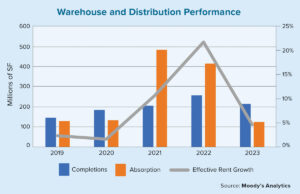In today’s commercial real estate lending space, as in many other arenas, we hear a lot about artificial intelligence (AI) and machine learning along with the roles they will play in the technological revolution. While these tools will undoubtedly have a tremendous impact, when should we expect this to take place in the commercial mortgage industry?
Experts say AI could manage market data, create online virtual tours, identify inconsistencies in paperwork, streamline client support and refine property comparisons to identify the best deal.
AI is tied to the process of developing technology systems or machines that perform tasks previously done by human beings. People generally refer to AI when describing the ability to make decisions or perform analyses rather than simply automating mundane processes. Machine learning is a discipline within AI that involves teaching a computer to do a task through repetition and data processing. Typically, as more repetition takes place and more data is processed, the learning is improved until optimization occurs.
Dream versus reality
The allure of leveraging AI and machine learning is simple and powerful. Imagine a technology that can take property data and immediately develop an informed view on its valuation. Experts say AI could manage market data, create online virtual tours, identify inconsistencies in paperwork, streamline client support and refine property comparisons to identify the best deal. Mortgage professionals are bullish on the powerful potential of these technologies.
Loan originators will use AI and machine learning to help lenders screen deals more effectively and, ultimately, to underwrite transactions more effectively at scale. Ideally, a lender will be able to drag and drop a set of files into a software application and the technology will explain what is missing. Once all information is provided, the application will conduct a detailed analysis and form conclusions that can be validated by human cross-checking. Lenders will make better decisions and complete more deals by automating manual workflows, and they will perform AI-informed decisionmaking that will be more data-driven, scientific and accurate.
But are the commercial real estate and mortgage industries ready to broadly implement these processes, and can they expect quick results and success from doing so? The answer is likely “not yet” on both fronts. That said, there are surely common-use cases where impacts can be made today. The question becomes, how close do these situations come to being the magic AI products that many promote them to be?
When considering the current state of data and work–flows within the commercial mortgage space, it’s imperative that technology providers are first able to generate a clean data set and system of record.
To adequately answer such questions requires an understanding of the industry and how far it has (or hasn’t) come to date. Many companies are
putting forth AI- and machine learning-based solutions that are automating common, tedious workflows for which these technologies are well suited. But much of the industry is still operating with manual data entry, reporting and analysis while grappling with the redundancy, errors and losses that accompany this work style.
In general, while it is possible to do both simple and complex tasks simultaneously, the process can break down when the complex initiatives are dependent on the completion of the simple ones. What value does AI or machine learning have if it is powered by inaccurate, incomplete or irrelevant data? The commercial mortgage industry must continue to make significant strides with its data practices and create a foundation for technology to deliver value.
Finding accurate data
So, how do we go about transforming the ways we work with data to automate the process and improve the decisions we make? That will take some doing.
According to
a study published by the Harvard Business Review that involved 75 corporate executives, only 3% of respondents found that their departments fell within the minimum acceptable range of 97% accuracy in their data records. While the study looked at multiple industries, the same principles apply to commercial real estate finance.
It is of utmost importance that lenders can rely on the data available to them to make informed decisions for their portfolios. Even the smallest spreadsheet or data entry error can have a massive ripple effect on a lender’s bottom line — and various studies show that nearly 90% of spreadsheets contain at least one critical error.
When considering the current state of data and workflows within the commercial mortgage space, it’s imperative that technology providers are first able to generate a clean data set and system of record. They can then unlock value downstream as a result of the data.
Trouble harnessing data
In commercial real estate, both lenders and property owners manage two primary types of data: external (from third parties) and internal, which is data gathered through operating records and shared among stakeholders working on a transaction. While external data is often more structured and shareable through application programming interfaces and other means, internal data is significantly harder to harness.
Much of the information related to real estate investments resides in separate systems, spreadsheets or emails, making it difficult to track and aggregate. Because of such issues, the first wave of technologies that sought to tackle this problem within commercial real estate developed a purely web-based user experience. This required lenders to fill out disparate forms to track data in an effort to introduce more structure to these internal data sets.
These technologies were not readily adopted given one massive operational cost: duplicative data entry. Finance professionals find comfort in routine and familiar ways of working. The nuances of commercial real estate require digital best practices, but these practices must complement existing workflows and actually be adopted to be efficient.
Improving workflows
When a lending institution fully adopts a technology solution, it should actually improve existing processes or workflows, not just force migration to a digital workspace. Done correctly, digital transformation will centralize and facilitate the rapid improvement of data capture and the projects that data impacts.
When it comes to digital transformation for commercial real estate, the tools that are successfully adopted by originators and lenders will be the ones that seamlessly integrate with how they’re already managing these highly structured projects. They will help collect and store data, use AI-based analytics and insights, and facilitate collaboration for all parties involved. The value created from this kind of approach dramatically reduces operational inefficiencies, saving lenders money and enabling them to make better investment decisions.
So, is AI the answer that commercial real estate finance has been searching for? If every borrower, broker and lender had the data they required in a clean, real-time database accessible in the cloud by all stakeholders, it would likely be highly transformative. A study by management and consulting company Bain found that companies leveraging advanced analytics capabilities
outperform their competition by a large margin.
Unfortunately, using AI and machine learning to deliver such results relies on a technological maturity level that commercial mortgage companies are just starting to build toward. As the industry moves along this maturity scale, it will make incremental changes in workflows and processes that deliver more value over time. When we reach the goal of having clean, accurate data we need at our fingertips — and gain the ability to draw value from that data — artificial intelligence tools will truly be the answer we seek. ●
-
Jeff Saul is helping to lead Built Technologies’ strategy for delivering value to commercial mortgage lenders while continuing to grow the company’s construction and real estate finance technology. Bringing more than eight years of lending experience to the role, Saul spent time in investment banking and real estate private equity, most recently at Starwood Capital, before helping to launch lender software platform Nativ in 2018. Nativ was designed to simplify commercial real estate deal management and was acquired by Built earlier this year.
View all posts






